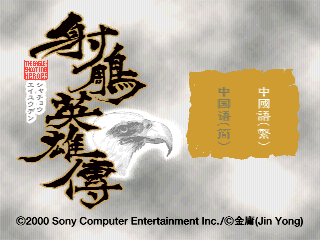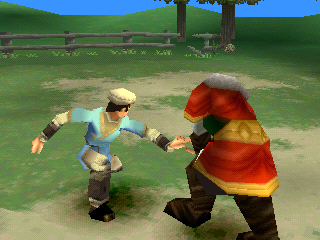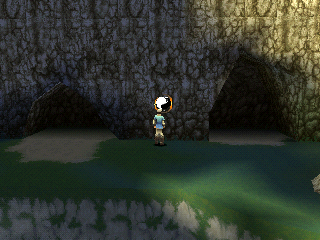Retro Replay Review
Gameplay
The moment you step into Shachō Eiyūden: The Eagle-Shooting Heroes, you’re greeted by an expansive world that faithfully captures the spirit of a classic Japanese-style RPG. Players take on the role of Guo Jing, traversing a richly detailed Song Dynasty China, from bustling market towns to misty mountain fortresses. Exploration plays a central role—hidden shrines, ancient dungeons, and side quests abound, each offering new martial arts scrolls or character backstory snippets to reward the curious.
(HEY YOU!! We hope you enjoy! We try not to run ads. So basically, this is a very expensive hobby running this site. Please consider joining us for updates, forums, and more. Network w/ us to make some cash or friends while retro gaming, and you can win some free retro games for posting. Okay, carry on 👍)
Combat hinges on a clever “rock, paper, scissors” system built around three martial arts disciplines: Qing Gong (lightness), Nei Gong (inner energy), and Wai Gong (physical force). Each discipline has one clear strength and one explicit vulnerability. As Guo Jing and his allies grow stronger, you’ll learn to read enemy telegraphs, chaining Qing Gong leaps into devastating Wai Gong strikes or bolstering Nei Gong counters to turn the tide of battle. Skill trees branch out, allowing you to specialize in acrobatic maneuvers, healing inner arts, or raw power blows—ensuring every party member feels distinct.
Beyond turn-based skirmishes, the game’s FMV cutscenes and full voice–acting elevate crucial story beats. Transitions between gameplay and cinematic sequences feel seamless, and dialogue is performed with genuine emotion, drawing you into the alliances and rivalries of the Five Greats. Dungeon layouts evolve with branching corridors, environmental puzzles, and occasional stealth sections, keeping exploration fresh. A robust quest log ensures you never lose track of the main plot while still indulging in side narratives that deepen your connection to Guo Jing’s companions.
Graphics
Shachō Eiyūden’s art direction strikes a harmonious balance between stylized character portraits and environments steeped in historical detail. Lush bamboo forests, crumbling pagodas, and sweeping river valleys evoke the grandeur of Song Dynasty China. Day–night cycles and dynamic weather effects—such as drifting snow or sudden downpours—add atmosphere and occasionally influence combat visibility or enemy behavior during outdoor encounters.
The integration of FMV sequences offers a nostalgic nod to late–90s RPG titles, yet it’s implemented with modern fidelity. Character models in these scenes display expressive animations, and backgrounds are hand-painted to match the in–engine world, preserving immersion. NPC faces during in–game cutscenes showcase subtle lip–syncing and facial cues, making emotional climaxes—such as betrayals or heartfelt farewells—land with genuine impact.
Performance remains smooth across both console and PC, with consistent frame rates even in more densely populated towns. UI elements are crisp and unobtrusive: inventory screens use parchment–style textures that echo the period, while menus load quickly, letting you dive back into exploration or battle with minimal downtime. In sum, the graphical presentation marries classic charm with modern polish, making every vista worth capturing.
Story
Based on Louis Cha’s beloved novel, Shediao Yingxiong Zhuan, the game faithfully adapts Guo Jing’s odyssey from innocent youth to legendary hero. Early chapters introduce his humble upbringing on the Mongolian plains, while later acts plunge you into the political intrigues of Jin–Song conflict. Along the way, you interact with iconic figures—the fierce martial artist Huang Rong, the enigmatic Ouyang Feng, and the scholarly Hong Qigong—each faithfully realized and voiced to reflect their literary personas.
Pacing is a standout strength: main story beats unfold at a measured pace, giving players time to explore secondary arcs that flesh out the era’s martial arts lore. Subplots—such as Guo Jing’s internal struggle to avenge his father versus his reluctance to shed blood—add emotional weight. Moments of humor and camaraderie, especially between Guo Jing and the quick–witted Huang Rong, provide levity and ensure the narrative never grows overly solemn.
Dialogue writing honors the novel’s wuxia traditions, balancing poetic flourishes with clear exposition. Even players unfamiliar with the source material will find the plot accessible, thanks to concise journal entries and optional lore codices. By the time you confront the central struggle against the Jin invaders or face off in high–stakes duels among the Five Greats, you’ll feel personally invested in Guo Jing’s journey from boyhood to martial arts legend.
Overall Experience
Shachō Eiyūden: The Eagle-Shooting Heroes delivers an engrossing blend of classic RPG mechanics, strategic combat, and a sweeping wuxia narrative. Fans of Jin Yong’s work will appreciate the fidelity to the source material, while newcomers can enjoy a well–crafted storyline that stands on its own. The interplay between exploration, tactical battles, and character development ensures that each play session feels rewarding.
That said, newcomers to turn–based RPGs may face a slight learning curve mastering the three–way martial arts system, and some pacing lulls occur during lengthy plot transitions. However, these moments are balanced by ambitious boss fights, varied dungeon designs, and engaging side quests that encourage experimentation with different party builds. Optional challenge modes and New Game+ paths extend replay value for completionists and veterans alike.
Ultimately, Shachō Eiyūden offers a rich, immersive adventure that captures the romance and heroism of Chinese wuxia tradition. Its thoughtful world–building, strategic depth, and memorable characters make it a standout title for RPG enthusiasts seeking an Eastern twist on the genre. Whether you’re drawn by the promise of legendary martial arts or the chance to step into Guo Jing’s shoes, this game delivers a thoroughly satisfying journey from first strike to final cutscene.
 Retro Replay Retro Replay gaming reviews, news, emulation, geek stuff and more!
Retro Replay Retro Replay gaming reviews, news, emulation, geek stuff and more!









Reviews
There are no reviews yet.